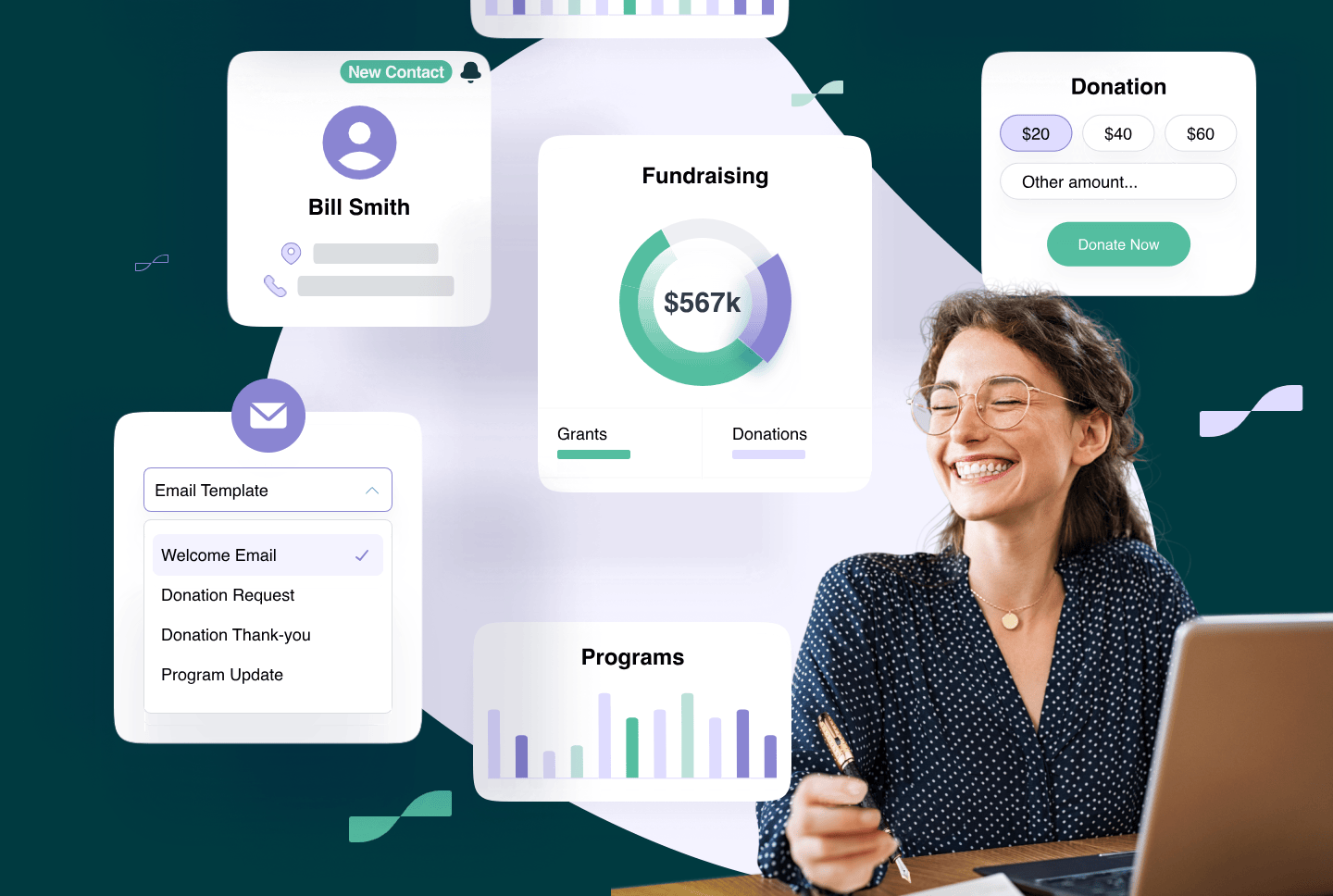Free Nonprofit Budget Template
Running a nonprofit is hard work, and an essential part of that is budgeting. Since we’re in the business of helping nonprofits, and creating the tools they need to do more good, we wanted to help by creating a sample nonprofit budget template that is free to download and use.
But we ended up creating three: an annual nonprofit organization budget template, an operating budget template, and a grant proposal budget template.
Find more templates for executives and board members in our 100% free nonprofit board portal.

#1 Annual Nonprofit Budget Template
This sample budget for nonprofits is a template for an organizational budget for a fiscal year. This includes program expenses, staff salaries, an operating budget and other expenditures. Once finalized you can create the nonprofit budget template in excel to make it easy for you to update next year.
#2 Nonprofit Operating Budget Template
A nonprofit operating budget reflects the organization’s planned financial activities, showing how much it will spend on operations. Executive directors should plan and make sure the budget plan is centered around the primary goals and objectives of your organization.
#3 Nonprofit Grant Proposal Budget Template
This nonprofit budget example caters to nonprofits who need to send cash flow projections and budgets to funding organizations in order to secure grant monies.
The template includes a revenue summary section that calculates your total grant income and a net section to help you quickly determine your program’s financial sustainability.
Creating Your Own Nonprofit Budget
Does your nonprofit keep track of its monthly income sources and expenses?
Proper budgeting can help make sure you use resources effectively, prevents overspending and ensures the financial health of your organization.
Plus, with a budget plan you’ll be better able to manage operations with limited funds.
That’s why we’ve put together this guide to making your own program budget – with a nonprofit budget template free!
What is a nonprofit budget?
A nonprofit budget is a financial document that provides a detailed view of how the organization plans to spend its money, and what it aims to achieve over a 12-month period.
While your budget will evolve along with your nonprofit, it will always include two things:
- Sources of revenue: donations, grants or any earnings from your campaigns (ticket sales, fees for services)
- Operating expenses: direct costs such as staff salaries, program costs, administrative expenses and overheads
Once adopted, nonprofit operating budgets become an essential financial management tool to plan and monitor operations and organizational activities through the year.
Nonprofits can use different budget plans, including
- Operating budgets: break down operating expenses, staff salaries and overall costs
- Grant budgets: outline total expenses when spending grant monies
- Marketing budgets: focused on advertising your organization (digital marketing, social media) and fundraising events
To help you through the budgeting process we’ll walk you through every line item you might need to include and show you how to create your own nonprofit organization budget template.
Why is a nonprofit budget template essential?
A nonprofit operating budget is a fundamental tool.
It demonstrates your ability to responsibly manage financial resources and provides a roadmap for activities in the upcoming year.
A budget describes your project in numbers just as a proposal describes it in words. A clear annual budget template serves as a critical document for donors, corporate investors and other potential funders who look at financial management and project budgets when making decisions to support your work. Often funders will look at the budget component of your proposal before they read anything else.
A good nonprofit organization budget template will:
- Helps you focus on short and long-term strategic goals. The availability of funding is directly connected to your program activities. A strategic budget plan ensures that you focus on your mission while keeping costs in line with revenue and are able to fulfill both your short-term and long-term goals.
- Get better feedback from board members. A clear budget ensures that board members can easily understand your overall plans, which programs or initiatives are performing well, and provide you with more valuable feedback and support.
- Keep donors informed. Donors today care about transparency and the impact of their donations. Even sharing a high-level summary of your budget will give them a clear sense of how they are contributing to change, and make it more likely that they will continue to support your work.
How to create a nonprofit budget template
In this section, we’ll look at a few key steps you’ll need to create an effective nonprofit budget sample.
Start planning in advance
Nonprofit budgeting takes time. Make sure you set aside enough time to gather information and discuss various elements of the budget.
Rushing the budgeting process could cause errors, which could result in future issues – especially troubling for nonprofits who need to report their finances and budgeting to grantors.
Start working on an excel sheet a few months in advance so you have time to get input from relevant stakeholders, gain approval from your board and present the budget to your entire team before the end of the fiscal year.
Understand Your Organization’s Goals
Your budget is what turns your goals into a reality. If you don’t know what your goals are, your budget plan will fail to reflect them, and you might end up overspending on programs that don’t further the core purpose of your mission.
Before you look at program expenses, set a meeting with executive directors to get clear on what you need to focus on so you can budget accordingly.
It’s important to focus on annual goals, but make sure you also look beyond what you want to achieve this year, and include line items in your budget for long-term goals.
Get Your Team Involved
Involve your Board, Executive directors, staff members, and even volunteers during the budgeting process. This will not only help create a more accurate and comprehensive budget but also ensures buy-in from key stakeholders.
While this might be challenging (and often messy!) process, it is a great way to bring in and unite various perspectives, creating a budget that reflects the priorities of everyone in your organization.
Set Costs with Suppliers and Partners
Work to develop lasting relationships with any vendors, suppliers and partners as this will save you time, energy, and even money! Setting costs with them early on will make budgeting easier and help you avoid guesswork.
Forming new connections you can trust takes time and effort – so work on keeping the ones you have as this will help you in the long-term.
Identify Expenses
Start with a nonprofit budget template excel sheet that includes all the expenses you can think of. Ask different teams for their annual expenses and estimated costs.
Everyone in your nonprofit will have different expertise, so check in on what they might know that you don’t.
An accounting software might be a better way to gather expenses than google sheets, so look into tools that make it easier to track your finances! Many provide discounted rates for nonprofits.
Define Revenue Streams
You’ll also want to get a clear idea of your revenue streams to understand where your money is coming from.
Getting an idea of what these streams are – whether donations, fundraising, corporate giving or grants – will help you see how useful each of them are to your organization in the long-term and help you work on building sustainability.
Figure Out Cash Flow Projection
Your cash flow is the movement of money that comes in and out of your organization.
Understanding your cash flow is extremely important in order to make assumptions about future spending. Before you create a budget, make sure you have a clear idea of how much you spend (and receive!) on a monthly basis so you can create accurate projections.
You also want to pay close attention to different budgets within your nonprofit’s plan. Take stock of your marketing budget, grant budget, operational budget and various project budgets as they will help you understand the health of your organization, where spending is needed, and set a clear budget for the upcoming fiscal year.
Pro-Tip: Separate your operational budget from your capital budget. Operational budgets sometimes involve one-time investments (like new computers for staff or a new website), so it’s best to keep these separate from a capital budget that is dedicated towards a specific program as you will be able to clearly see expenses and costs for every project.
Monitor your budget
Your annual nonprofit budget is a living document. While you might have a comprehensive nonprofit business plan – situations can change, and so will your budget.
It is good practice to monitor your budget every month and compare predicted numbers to the actual figures to look for differences and understand why they occurred. If you are not in line with your projected budget, look at what changed or what could have been controlled.
This is where your budget becomes an effective management and operations tool. For example, you can determine which projects need to be updated and which areas or departments need to develop new ideas for your organization to reach its goals and move forward with its mission in the next fiscal year.
Create a clear budgeting process
You’ll need a program budget every year, so get your docs in order for the years ahead and plan a clear budgeting process.
Use a free template to get you started and once you’ve added any unique requirements to it, this can be reused for subsequent budgeting sessions. It also helps to use a standard format for budgets as you can compare them and track growth and changes over the years.
Clearly note the process you adopted and any changes you’d like to make to it, based on your experience and the feedback of your team. Setting out a process will help you develop more accurate budgets that reflect the priorities of your organization and keep you on track.
What to include in your nonprofit budget template
When you create a nonprofit budget sample, you’ll first need to develop an exhaustive list of program expenses. To make sure you don’t forget anything critical, here’s a look at several key areas you need to include in a program budget plan.
Staff expenses
The biggest expenditures of small businesses and nonprofit organizations are usually staff salaries. But salaries aren’t the only expenditures nonprofit leaders should plan for. Employee expenses also include:
- Benefits: This includes health insurance, 401(k), vacation days, parental leave, and other perks you offer
- Taxes: While nonprofit organizations don’t pay state or federal income taxes, they must pay employee taxes for staff
- Volunteer management: A team of volunteers can significantly cut down on payroll but you will need to budget for snacks, branded goodie bags or a volunteer appreciation event once a year
Facilities Expenses
Whether you’re a startup or have been around for years, you will need to account for the costs of facilities and maintenance in your nonprofit operating budget. This includes:
- Rent: The rent or the mortgage on your main office and any other properties that you use to run the organization. You must also include parking fees, property taxes (if any), and fees for any coworking spaces.
- Utilities: Utilities make up most of your operating budget and include bills for gas, electric, water, and cable/internet fees.
- Maintenance: You must make sure that your team is given a safe, clean working environment. You will need to account for monthly cleaning fees, repair costs, or new equipment for employee welfare like a microwave or coffee machine.
Administrative expenditure
Administrative costs include a wide range of expenses that are related to office supplies, technology and software subscriptions, or even postage. Consider the following items during an admin budget allocation:
- Technology: Tools and technology are required by most departments and will need to be accounted for. These include project management software, nonprofit CRM software, Microsoft Office (for access to Powerpoint Word and Excel), accounting software, or other tools for financial management.
- Office supplies: Includes desks and chairs, stationery, and printers. If you have remote employees, create a reimbursement plan for their home office purchases.
- Printing: You will need to print materials for nonprofit programs and fundraising campaigns, such as flyers, signage, or even t-shirts. Develop separate budgets for printing campaign materials (which require the help of professional printers), and everyday office printing requirements that you can do in-house.
Program expenses
The budgeting process for programs varies widely and depends on the sector and type of work your organization does. You Here are some examples of the unique program expenses some nonprofits require:
- Educational organizations: These might need to account for academic scholarship costs, school meals, books, technology subscriptions, or school supplies.
- Sustainability organizations: Such organizations might need to budget for research and development, public awareness campaigns, or supplies for clean-up crews.
- Health organizations: Budget allocations for health organizations could include medicines or vaccinations, nursing staff, educational campaigns and even facilities or medical testing equipment.
Some organizations might also include admin or facilities expenditures in their program budget allocation.
Marketing and fundraising expenses
Part of running a nonprofit business is ensuring you have enough revenue sources to support your programs. Marketing and fundraising are therefore key expense centers and must be accounted for in your nonprofit budget template:
Here are a few line items you might want to include in your marketing budget:
- Marketing expenses: Besides the marketing team, expenses might include graphic design tools, social media scheduling software or hiring a marketing or PR agency
- Advertising: Creating ad budgets for digital marketing on platforms like Instagram or Facebook or even advertising in your local newspaper or other magazines and journals. Some platforms might provide discounted rates for nonprofits, for example Google ads, gives free access to nonprofits – so make sure you look for such offers!
- Fundraising events: These include the expenses from annual fundraising events, silent auctions, webinars or ticketed events that you host to raise money (A donation and fundraising management software like Sumac’s can help make this easy for you!)
- Grant proposals: You may need a grant writing expert or copywriter to submit grant proposals to various funding organizations.
How to use these nonprofit budget templates
A sample nonprofit budget is a fillable document that simplifies the budgeting process for you as it includes all the typical line items of revenue sources and expenses, saving you time creating your own.
How you use the nonprofit budget examples below is up to you! You can keep all the information in one excel sheet, or break it up into different pages. But make sure you delete any line items that don’t apply to your work and add anything that’s missing.
A nonprofit budget template Excel creates is pretty similar to a nonprofit budget template Google Sheets does – so don’t be overly concerned about the platform. Use whatever your team is familiar with and suits your needs.
If you’re looking for additional ways to streamline operations and fundraising, take a look at Sumac’s donation management software.
You Might Also Like:
14 Measurements Every Charity Should Track
Nonprofit Annual Report Templates and Examples
How to Write a Grant Report (Including Grant Reporting Template)


